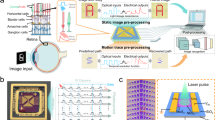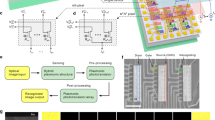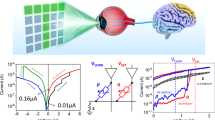Abstract
Memristors with photonic sensory capabilities can be used as elements in machine vision systems but face challenges in terms of encoding and processing optical data. This has led to different neural network architectures being developed for specific vision tasks, which limits progress towards more versatile in-sensor vision computing platforms. Here we describe a multi-phototransistor and one-memristor array that is based on niobium oxide memristors. It has reconfigurable dynamics and is compatible with both machine learning (analogue) and bioinspired (spiking) neural network architectures. The array can sense and process optical images and synchronize spatio-temporal data across different encoding formats. When the array is coupled with a classifier network using a one-transistor and one-memristor non-volatile memory array, it supports a variety of optical neural networks (including optical convolutional neural networks, recurrent neural networks and spiking neural networks). The resulting system can perform various computing vision tasks, such as recognizing static, motion and colour images.
This is a preview of subscription content, access via your institution
Access options
Access Nature and 54 other Nature Portfolio journals
Get Nature+, our best-value online-access subscription
$32.99 / 30 days
cancel any time
Subscribe to this journal
Receive 12 digital issues and online access to articles
$119.00 per year
only $9.92 per issue
Buy this article
- Purchase on SpringerLink
- Instant access to full article PDF
Prices may be subject to local taxes which are calculated during checkout






Similar content being viewed by others
Data availability
Source data are available via Zenodo at https://doi.org/10.5281/zenodo.13747890 (ref. 56). Source data are provided with this paper. Other data that support the findings of this study are available from the corresponding author upon reasonable request.
Code availability
The codes used for the simulations are available via Zenodo at https://doi.org/10.5281/zenodo.13747890 (ref. 56). Other codes used for data plotting are available from the corresponding author upon reasonable request.
References
Gu, L. et al. A biomimetic eye with a hemispherical perovskite nanowire array retina. Nature 581, 278–282 (2020).
Wu, J. et al. An integrated imaging sensor for aberration-corrected 3D photography. Nature 612, 62–71 (2022).
Long, Z. et al. A neuromorphic bionic eye with filter-free color vision using hemispherical perovskite nanowire array retina. Nat. Commun. 14, 1972 (2023).
Merolla, P. A. et al. A million spiking-neuron integrated circuit with a scalable communication network and interface. Science 345, 668–673 (2014).
Ielmini, D. & Wong, H. S. P. In-memory computing with resistive switching devices. Nat. Electron. 1, 333–343 (2018).
Zidan, M. A., Strachan, J. P. & Lu, W. D. The future of electronics based on memristive systems. Nat. Electron. 1, 22–29 (2018).
Sebastian, A. et al. Memory devices and applications for in-memory computing. Nat. Nanotechnol. 15, 529–544 (2020).
Zhang, W. et al. Neuro-inspired computing chips. Nat. Electron. 3, 371–382 (2020).
Wang, Z. et al. Resistive switching materials for information processing. Nat. Rev. Mater. 5, 173–195 (2020).
Zhou, F. & Chai, Y. Near-sensor and in-sensor computing. Nat. Electron. 3, 664–671 (2020).
Chai, Y. In-sensor computing. Nature 579, 32–33 (2020).
Kaspar, C. et al. The rise of intelligent matter. Nature 594, 345–355 (2021).
Zhou, F. et al. Optoelectronic resistive random access memory for neuromorphic vision sensors. Nat. Nanotechnol. 14, 776–782 (2019).
Hu, L. et al. All-optically controlled memristor for optoelectronic neuromorphic computing. Adv. Funct. Mater. 31, 2005582 (2021).
Mennel, L. et al. Ultrafast machine vision with 2D material neural network image sensors. Nature 579, 62–66 (2020).
Yao, P. et al. Fully hardware-implemented memristor convolutional neural network. Nature 577, 641–646 (2020).
Lee, S. et al. Programmable black phosphorus image sensor for broadband optoelectronic edge computing. Nat. Commun. 13, 1485 (2022).
Zhang, Z. et al. All-in-one two-dimensional retinomorphic hardware device for motion detection and recognition. Nat. Nanotechnol. 17, 27–32 (2022).
Sun, L. et al. In-sensor reservoir computing for language learning via two-dimensional memristors. Sci. Adv. 7, eabg1455 (2021).
Lee, D. et al. In-sensor image memorization and encoding via optical neurons for bio-stimulus domain reduction toward visual cognitive processing. Nat. Commun. 13, 5223 (2022).
Liu, K. et al. An optoelectronic synapse based on α-In2Se3 with controllable temporal dynamics for multimode and multiscale reservoir computing. Nat. Electron. 5, 761–773 (2022).
Zhang, Z. et al. In-sensor reservoir computing system for latent fingerprint recognition with deep ultraviolet photo-synapses and memristor array. Nat. Commun. 13, 6590 (2022).
Wu, X. et al. Wearable in-sensor reservoir computing using optoelectronic polymers with through-space charge-transport characteristics for multi-task learning. Nat. Commun. 14, 468 (2023).
Wu, Q. et al. Spike encoding with optic sensory neurons enable a pulse coupled neural network for ultraviolet image segmentation. Nano Lett. 20, 8015–8023 (2020).
Chen, J. et al. Optoelectronic graded neurons for bioinspired in-sensor motion perception. Nat. Nanotechnol. 18, 882–888 (2023).
Wang, F. et al. A two-dimensional mid-infrared optoelectronic retina enabling simultaneous perception and encoding. Nat. Commun. 14, 1938 (2023).
Wang, X. et al. Vertically integrated spiking cone photoreceptor arrays for color perception. Nat. Commun. 14, 3444 (2023).
Zhou, Y. et al. Computational event-driven vision sensors for in-sensor spiking neural networks. Nat. Electron. 6, 870–878 (2023).
Dang, B. et al. One-phototransistor-one-memristor array with high-linearity light-tunable weight for optic neuromorphic computing. Adv. Mater. 35, 2204844 (2022).
Ma, S. et al. A 619-pixel machine vision enhancement chip based on two-dimensional semiconductors. Sci. Adv. 8, eabn9328 (2022).
Pei, J. et al. Towards artificial general intelligence with hybrid Tianjic chip architecture. Nature 572, 106–111 (2019).
Wang, C.-Y. et al. Gate-tunable van der Waals heterostructure for reconfigurable neural network vision sensor. Sci. Adv. 6, eaba6173 (2020).
Li, T. et al. Reconfigurable, non-volatile neuromorphic photovoltaics. Nat. Nanotechnol. 18, 1303–1310 (2023).
Lübben, M., Wiefels, S., Waser, R. & Valov, I. Processes and effects of oxygen and moisture in resistively switching TaOx and HfOx. Adv. Electron. Mater. 4, 1700458 (2018).
Valov, I. & Tsuruoka, T. Effects of moisture and redox reactions in VCM and ECM resistive switching memories. J. Phys. D: Appl. Phys. 51, 413001 (2018).
Wang, W. et al. A self-rectification and quasi-linear analogue memristor for artificial neural networks. IEEE Electron Device Lett. 40, 1407–1410 (2019).
Wang, R. et al. Deep reservoir computing based on self-rectifying memristor synapse for time series prediction. Appl. Phys. Lett. 123, 042109 (2023).
Konstantin, V. E. et al. Hydrogen radical enhanced atomic layer deposition of TaOx: saturation studies and methods for oxygen deficiency control. J. Mater. Chem. C 6, 9667–9674 (2018).
Xu, J. H., Jarlborg, T. & Freeman, A. J. Self-consistent band structure of the rutile dioxides NbO2, RuO2, and IrO2. Phys. Rev. B 40, 7939 (1989).
Aziz, J. et al. Chemical nature of electrode and the switching response of RF-sputtered NbOx films. Nanomaterials 10, 2164 (2020).
Chen, W.-T., Hsueh, H.-W., Zan, H.-W. & Tsai, C.-C. Light-enhanced bias stress effect on amorphous In-Ga-Zn-O thin-film transistor with lights of varying colors. Electrochem. Solid-State Lett. 14, H297 (2011).
Nahm, H. H. & Kim, Y. S. Undercoordinated indium as an intrinsic electron-trap center in amorphous InGaZnO4. NPG Asia Mater. 6, e143 (2014).
Jeong, J. K. et al. Origin of threshold voltage instability in indium-gallium-zinc oxide thin film transistors. Appl. Phys. Lett. 93, 123508 (2008).
Jang, H. et al. In-sensor optoelectronic computing using electrostatically doped silicon. Nat. Electron. 5, 519–525 (2022).
Chen, Z. et al. All-ferroelectric implementation of reservoir computing. Nat. Commun. 14, 3585 (2023).
Milano, G. et al. In materia reservoir computing with a fully memristive architecture based on self-organizing nanowire networks. Nat. Mater. 21, 195–202 (2022).
Chen, Y.-L., Lu, C.-C., Juang, K.-C. & Tang, K.-T. Conversion of artificial neural network to spiking neural network for hardware implementation. In Proc. 2019 IEEE International Conference on Consumer Electronics 1–2 (IEEE, 2019).
Wu, Z. et al. Threshold switching memristor-based radial-based spiking neuron circuit for conversion based spiking neural networks adversarial attack improvement. IEEE Trans. Circuits Syst. II: Express Briefs 71, 1446–1450 (2024).
Pang, B., Nijkamp, E. & Wu, Y. Deep learning with TensorFlow: a review. J. Educ. Behav. Stat. 45, 227–248 (2020).
Reyad, M., Sarhan, A. & Arafa, M. A modified Adam algorithm for deep neural network optimization. Neural Comput. Appl. 35, 17095–17112 (2023).
Ho, Y. & Wookey, S. The real-world-weight cross-entropy loss function: modeling the costs of mislabeling. IEEE Access 8, 4806–4813 (2020).
Liu, Q. & Furber, S. (2016). Noisy softplus: a biology inspired activation function. In Neural Information Processing. ICONIP 2016. Lecture Notes in Computer Science Vol. 9950 (eds Hirose, A et al.) 405–412 (Springer, 2016).
Dominey, P. F. Narrative event segmentation in the cortical reservoir. PLoS Comput. Biol. 17, e1008993 (2021).
Du, C. et al. Reservoir computing using dynamic memristors for temporal information processing. Nat. Commun. 8, 2204 (2017).
Ding, J. et al. Optimal ANN-SNN conversion for fast and accurate inference in deep spiking neural networks. In Proc. 30th International Joint Conference on Artificial Intelligence (ed. Zhou, Z.-H.) 2328–2336 (International Joint Conference on Artificial Intelligence Organization, 2021).
Dang, B. Reconfigurable in-sensor processing based on a multi-phototransistor–one-memristor array. Zenodo https://doi.org/10.5281/zenodo.13747890 (2024).
Acknowledgements
This work was supported by the National Key R&D Program of China (Grant No. 2023YFB4502200), the National Natural Science Foundation of China (Grant Nos 61925401, 92064004, 61927901, 8206100486 and 92164302), the Beijing Natural Science Foundation (Grant No. L234026) and the 111 Project (Grant No. B18001).
Author information
Authors and Affiliations
Contributions
B.D. and Y.Y. designed the study. B.D. fabricated the MP1R array and the vision computing test system and performed the electrical measurements. T.Z. and B.D. prepared the 1T1R memristor array. B.D., T.Z., R.H. and Y.Y. developed the 1T1R non-volatile memristor array integration processes. B.D. performed the ex situ TEM characterization. B.D. demonstrated the application of OCNNs, ORNNs and OSNNs in optical image recognition. B.D., X.W., K.L. and Y.Y. prepared the manuscript. Y.Y. directed all the experimental research and supervised this work. All authors analysed the results and implications and commented on the manuscript at all stages.
Corresponding author
Ethics declarations
Competing interests
The authors declare no competing interests.
Peer review
Peer review information
Nature Electronics thanks Hongwei Tan and Ilia Valov for their contribution to the peer review of this work.
Additional information
Publisher’s note Springer Nature remains neutral with regard to jurisdictional claims in published maps and institutional affiliations.
Supplementary information
Supplementary Information
Supplementary Figs. 1–29, Table 1 and discussion.
Source data
Source Data Figs. 2–6
Data underlying Figs. 2c–j, 3b,c, 4g–i,k, 5d,g and 6b,d–g.
Rights and permissions
Springer Nature or its licensor (e.g. a society or other partner) holds exclusive rights to this article under a publishing agreement with the author(s) or other rightsholder(s); author self-archiving of the accepted manuscript version of this article is solely governed by the terms of such publishing agreement and applicable law.
About this article
Cite this article
Dang, B., Zhang, T., Wu, X. et al. Reconfigurable in-sensor processing based on a multi-phototransistor–one-memristor array. Nat Electron 7, 991–1003 (2024). https://doi.org/10.1038/s41928-024-01280-3
Received:
Accepted:
Published:
Issue date:
DOI: https://doi.org/10.1038/s41928-024-01280-3
This article is cited by
-
2D computational photodetectors enabling multidimensional optical information perception
Nature Communications (2025)
-
Optoelectronic polymer memristors with dynamic control for power-efficient in-sensor edge computing
Light: Science & Applications (2025)
-
Bioinspired high-order in-sensor spatiotemporal enhancement in van der Waals optoelectronic neuromorphic electronics
Nature Communications (2025)
-
A facile photonics reconfigurable memristor with dynamically allocated neurons and synapses functions
Light: Science & Applications (2025)
-
Capacitive in-sensor tactile computing
Nature Communications (2025)



